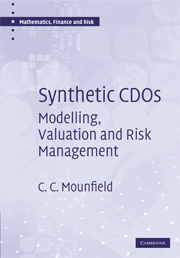Book contents
- Frontmatter
- Contents
- Preface
- Acknowledgements
- 1 A primer on collateralised debt obligations
- 2 Modelling of obligor default
- 3 Valuation of credit default swaps
- 4 Credit indices
- 5 Valuation of default baskets
- 6 Valuation of synthetic CDOs
- 7 Phenomenology of the standard market model
- 8 Risk quantification of synthetic CDOs
- 9 Implied and base correlations
- 10 Extensions of the standard market model
- 11 Exotic CDOs
- 12 Correlation trading of synthetic CDO tranches
- 13 Risk management of a portfolio of synthetic CDOs
- 14 Hedging simulation of structured credit products
- Appendix A Explanation of common notation
- Appendix B Simulated annealing
- References
- Index
8 - Risk quantification of synthetic CDOs
Published online by Cambridge University Press: 06 July 2010
- Frontmatter
- Contents
- Preface
- Acknowledgements
- 1 A primer on collateralised debt obligations
- 2 Modelling of obligor default
- 3 Valuation of credit default swaps
- 4 Credit indices
- 5 Valuation of default baskets
- 6 Valuation of synthetic CDOs
- 7 Phenomenology of the standard market model
- 8 Risk quantification of synthetic CDOs
- 9 Implied and base correlations
- 10 Extensions of the standard market model
- 11 Exotic CDOs
- 12 Correlation trading of synthetic CDO tranches
- 13 Risk management of a portfolio of synthetic CDOs
- 14 Hedging simulation of structured credit products
- Appendix A Explanation of common notation
- Appendix B Simulated annealing
- References
- Index
Summary
Introduction
In this chapter we continue our analysis of synthetic CDOs and their valuation within the standard model by quantifying the sensitivity of tranche PVs to fluctuations in input parameters. Several different risk measures commonly used in the marketplace will be introduced to facilitate this quantification.
Section 8.2 provides an overview of the different risk factors that synthetic CDOs are sensitive to and Section 8.3 describes the baseline case to be analysed (and justifies any simplifying assumptions made in the analysis). Broadly speaking risks can be classified as either market or credit variety. In Sections 8.4, 8.5 and 8.6 we introduce different measures to quantify the extent to which a position is sensitive to market and credit risk factors (specifically sensitivities to spreads, correlation and default respectively). These risk measures are similar to those previously introduced for single-name CDSs. However, the fact that we are now dealing with multiple obligors introduces additional complexities into the characterisation of risk. Section 8.7 analyses the time decay of a tranche as it's time-to-maturity decreases (as we will see this is an interesting quantity to analyse).
Value-at-risk (VaR) based measures are the subjects of Sections 8.8 and 8.9. Section 8.8 looks at credit spread VaR. This measure characterises the P/L uncertainty of a tranche as obligor credit spreads evolve over time. Section 8.9 introduces default VaR. This measure quantifies the impact of multiple obligor defaults over a specified time horizon on tranche P/L. Finally Section 8.10 reviews the key points introduced in the chapter.
- Type
- Chapter
- Information
- Synthetic CDOsModelling, Valuation and Risk Management, pp. 160 - 189Publisher: Cambridge University PressPrint publication year: 2008



